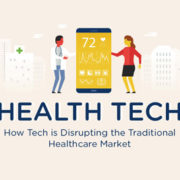What’s Happening With All Our Healthcare Data?

The following guest post on big data in healthcare was submitted by Keri Lunt Stevens.
Big data — two little words that have monstrous meaning. Big data is a term for a data set that is so large or complex that a traditional data processing application can’t handle it. From every student’s transcript to every hospital’s patient records and even to your own personal social media exchanges, we’re all producing data. All of the time.

The rising use of big data in healthcare promises to fundamentally improve care delivery.
According to IBM, an American multinational technology company, big data is arriving from multiple sources at an alarming velocity, volume, and variety. To extract meaningful value from big data, we need optimal processing power, analytics capabilities, and skills. Most industries struggle with this because the challenges of capturing, storing, sharing, searching, securing and updating this big data are real.
But so are the benefits. With the help of predictive analytics, big data can be used to anticipate future behavior, spot trends, and foresee and even stop potential problems before they spiral out of control. In the healthcare industry, this could have a huge impact on patient care, privacy and more.
Control Epidemics
In a way, predictive analytics isn’t new to the healthcare industry. For years, quantitative data has been used to predict the likelihood of an infectious disease outbreak, including how the disease will spread and how to control it. Some of these formal methodologies include risk factor analysis, risk modeling and dynamic modeling. But while quantitative data has helped us so far, it hasn’t been enough. Currently, there are five U.S.-based outbreaks being investigated by the Centers for Disease Control and Prevention. Additionally, the Zika virus — for which there is no vaccine — continues to spread. According to a U.S. National Library of Medicine National Institutes of Health article written by Mark Woolhouse, we need to develop a more holistic framework that captures the role of the underlying drivers of disease risks, from demography and behavior to land use and climate change. For a complete picture, doctors and scientists need to be able to cipher through quantitative and qualitative data to make predictions and act accordingly.
Develop Personalized Medicine
The majority of the human body is made up of six elements: oxygen, carbon, hydrogen, nitrogen, calcium and phosphorus, which are divided into simple and complex chemical molecules. The most common medical treatment, drug therapy, is the biochemical interactions between those molecules and the ones in pharmaceutical drugs. And that’s great. This type of treatment has helped heal millions of people worldwide. But it isn’t enough. Too many people are suffering because their bodies aren’t responding to treatments — from depression to blood pressure to cancer treatments.
Using a big data predictive analysis approach to personalized medicine could reduce the financial, social and personal burden associated with the current trial-and-error approach, according to Kateryna Babina, a medical scientist based in Australia. In an article on Budget Direct’s healthcare hub, Babina says integrating clinical, laboratory, lifestyle, behavioral and environmental factors into patient care is the key to helping provide personalized, targeted interventions to the right patients.
Keri Lunt Stevens is a freelance writer and editor who has worked in journalism and content marketing. Her experience ranges from healthcare trends and topics to finance and community news. Her work has been featured in a variety of print and online media outlets.









Leave a Reply
Want to join the discussion?Feel free to contribute!